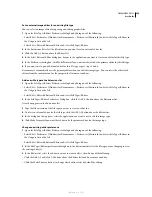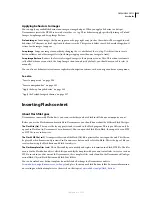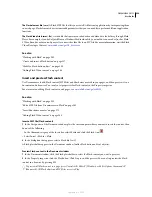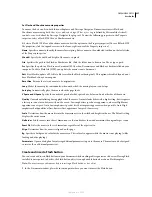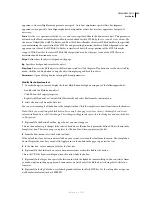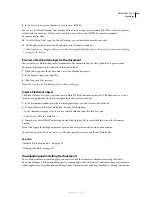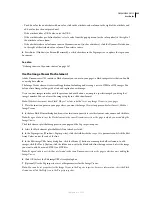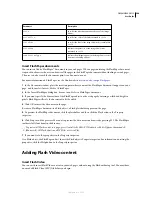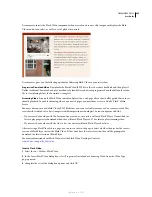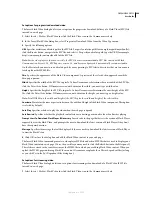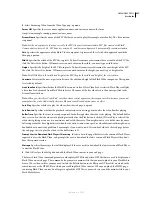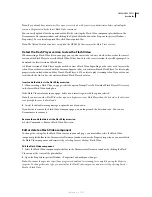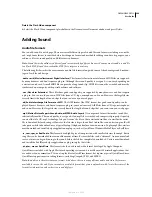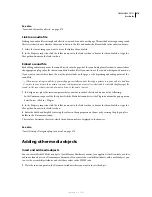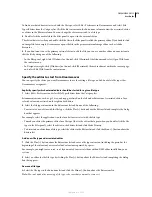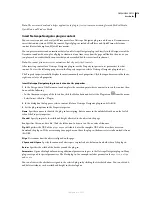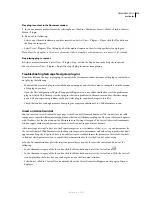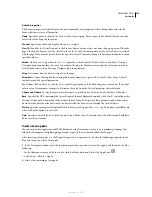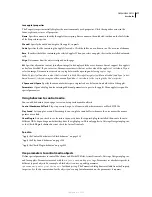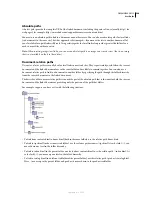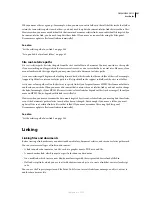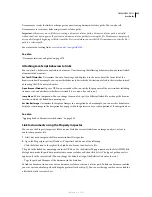
DREAMWEAVER CS3
User Guide
267
2
Select Streaming Video from the Video Type pop-up menu.
Server URI
Specifies the server name, application name, and instance name in the form
rtmp://www.example.com/app_name/instance_name.
Stream Name
Specifies the name of the FLV file that you want to play (for example, myvideo.flv). The .flv extension
is optional.
Note:
For the video player to function correctly, the FLV file must contain metadata. FLV files created with Flash®
Communication Server 1.5.2, FLV Exporter version 1.2, and Sorenson Squeeze 4.0 automatically contain metadata.
Skin
Specifies the appearance of the Flash Video component. A preview of the selected skin appears beneath the
Skin pop-up menu.
Width
Specifies the width of the FLV file, in pixels. To have Dreamweaver determine the exact width of the FLV file,
click the Detect Size button. If Dreamweaver cannot determine the width, you must type a width value.
Height
Specifies the height of the FLV file, in pixels. To have Dreamweaver determine the exact height of the FLV
file, click the Detect Size button. If Dreamweaver cannot determine the height, you must type a height value.
Note:
Total With Skin is the width and height of the FLV file plus the width and height of the selected skin.
Constrain
Maintains the same aspect ratio between the width and height of the Flash Video component. This option
is selected by default.
Live Video Feed
Specifies whether the Flash Video content is live. If Live Video Feed is selected, Flash Player will play
a live video feed streamed from Flash® Media Server. The name of the live video feed is the name specified in the
Stream Name text box.
Note:
When you select Live Video Feed, only the volume control appears on the component’s skin, because you cannot
manipulate live video. Additionally, the Auto Play and Auto Rewind options have no effect.
Auto Play
Specifies whether to play the video when the web page is opened.
Auto Rewind
Specifies whether the playback control returns to starting position after the video finishes playing.
Buffer Time
Specifies the time, in seconds, required for buffering before the video starts playing. The default buffer
time is set to 0 so that the video starts playing instantly after the Play button is clicked. (If Auto Play is selected, the
video starts playing as soon as a connection is made with the server.) You might want to set a buffer time if you are
delivering video that has a higher bit rate than the site visitor’s connection speed, or when Internet traffic might cause
bandwidth or connectivity problems. For example, if you want to send 15 seconds of video to the web page before
the web page starts to play the video, set the buffer time to 15.
Prompt Users to Download Flash Player if Necessary
Inserts code in the page that detects the version of Flash Player
required to view the Flash Video, and prompts the user to download the latest version of Flash Player if they don’t
have the required version.
Message
Specifies the message that will be displayed if the user needs to download the latest version of Flash Player
to view the Flash Video.
3
Click OK to close the dialog box and add the Flash Video content to your web page.
The Insert Flash Video command generates a video player SWF file and a skin SWF file that are used to display your
Flash Video on a web page. The command also generates a main.asc file that you must upload to your Flash Media
Server. (To see the new files, you may need to click the Refresh button in the Files panel.) These files are stored in the
same directory as the HTML file to which you’re adding Flash Video content. When you upload the HTML page
containing Flash Video content, don’t forget to upload the SWF files to your web server, and the main.asc file to your
Flash Media Server.
September 4, 2007


